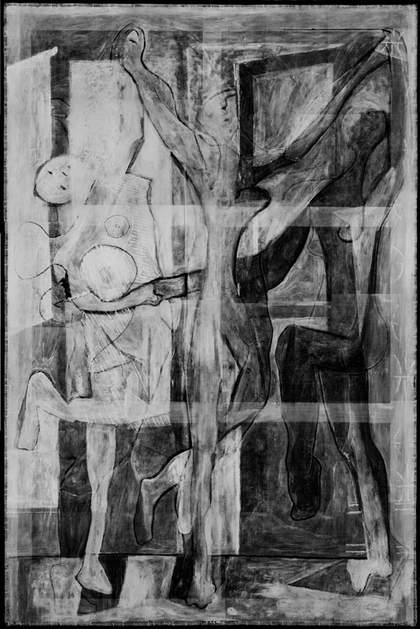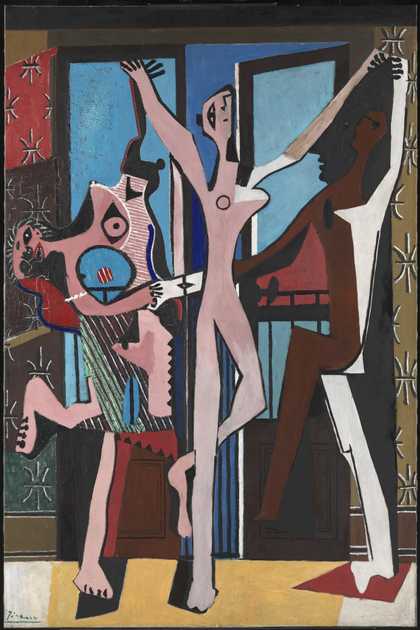The Three Dancers was painted in 1925 but remained in Picasso’s collection until he sold it to the (then) Tate Gallery in 1965. This was the first painting the he ever sold to a museum, and is heralded as a symbol of the Picasso’s affection for Britain. Its iconography and meaning has puzzled historians for decades, but its uniqueness also lies in the artist’s materials and application of the paint. Not only was Annette able to begin to analyse the surface, she also had to look beneath the surface for some clues.

Paintings conservator Annette King in the conservation studio.
Here’s an extract from her report:
“Picasso was apparently working on a painting of the Three Graces, prior to his visit to Monte Carlo with the Ballets Russes. On his return he is said to have completely transformed the image.
From an earlier x-ray [of The Three Dancers] one could already see that there was a very different painting underneath. The old x-ray had omitted the top and bottom bands of the painting and the contrast was very stark, not allowing for finer detail to emerge. A new x-ray was taken to include the missing areas, and the sensitivity of the new x-ray revealed details previously unseen.

Composite image of the new x-ray of Picasso's The Three Dancers, showing underpainting

Pablo Picasso
The Three Dancers (1925)
Tate
The figures appear more classical in form, with rounded limbs in balletic poses. The bottom of the painting is particularly interesting as two new feet are visible; one belonging to the figure on the left and one to the right hand figure. Both feet are much more rounded in shape, similar to features of his classical figures. The underlying foot on the right has defined toes, and is completely different to the abstracted shape which replaces it. These limbs can be traced upwards giving a clearer outline of the underlying figures. These are just initial findings and time will be spent looking closely at the x-ray and examining the painting in more detail.
The physical examination of the painting was also fascinating and helps us to understand more about Picasso’s painting technique. The large drying cracks in the left hand figure allow colour from the previous layers to show through. This in conjunction with the x-ray may allow a clearer understanding of the underlying image. The fact that the painting has cracked so dramatically is a result of painting thick oil paint over an already substantial layer of oil. Picasso apparently liked the appearance of these cracks and considered them part of the history of the painting.”
Technology enables us to continually discover new aspects of Picasso’s imagery and to think about his process. Were British artists as interested in Picasso’s latest innovations in applying paint as they were in his stylistic experiments? I like to think so.
The Three Dancers and many other Tate works were conserved and cleaned in preparation for the Picasso and Modern British Art exhibition with thanks to donations to the Tate Fund.
